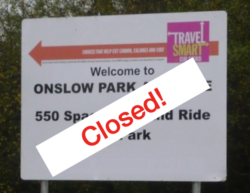Journey through Surrey's finest pubs, from historic inns to award-winning gastropubs, and uncover where your next memorable pint awaits.
In recent developments, the closure of the Onslow Park & Ride has sent ripples through the community, with many pointing to a series of missteps that ultimately led to its downfall. This article will dissect the multifaceted errors and missed opportunities that encapsulated the ill-fated project.
A Convoluted Start: Poor Signage and Access
The Onslow Park & Ride (P&R) faced navigational challenges from the beginning. Poor signage, which competed with the University P&R on weekends, created confusion among potential users. The convoluted access route was another significant hurdle. Despite concerns raised during its construction, the problematic entry and exit system were implemented, discouraging many from utilizing the service.
Pricing Strategy Flaws

Source: https://guildford-dragon.com/letter-a-chapter-of-errors-doomed-the-onslow-park-ride/
The decision to implement a pay-to-ride system rather than a pay-to-park model further alienated users. For instance, two individuals traveling into Guildford who opted for the P&R would spend £6, whereas parking directly in the town center cost only £4 for up to three hours. This discrepancy made the P&R option less financially viable for many, contributing to its underuse.
Missed Connections and Unfulfilled Potential
Rather than adopting a drive-through strategy, similar to the successful model in Winchester where P&R buses are free with a car park ticket and make multiple stops throughout the city, Onslow opted for a drive-to setup. Additionally, the service failed to cater to the needs of the nearby Royal Surrey Hospital. Extending the service hours and routing past the hospital could have significantly increased ridership and utility.
Operational Limitations
The P&R's operating hours were another critical failure. By not extending service into the evening, the P&R missed out on capturing a share of the evening economy and providing a viable option for commuters. Enhancing operational hours could have broadened its user base and improved its sustainability.
Lack of Amenities and Advertising
Opportunities to generate revenue through amenities for waiting passengers were overlooked. The site could have featured facilities and a shopping pick-up point, adding convenience and attracting more users. Furthermore, the lack of effective advertising dealt a critical blow. Unlike Merrow and Arrington, which were advertised on the Parkopedia website, Onslow P&R had no such presence, leading to lower visibility and awareness.
The Aftermath and Future Prospects
With the closure imminent, the focus shifts to potential future uses for the site. A feasible proposal is to temporarily convert it into a shuttle car park for the hospital. This would allow redevelopment of the existing hospital car park into a multi-level facility, thereby enhancing the visitor experience. Addressing the longstanding issues with Beechcroft Drive access should also be a priority in this transition.
Conclusion: A Systemic Failure, Not an Inherent One
The collapse of the Onslow Park & Ride should not be seen as a failure of the P&R concept but a result of flawed design, implementation, and management. As Guildford Borough Council (GBC) embarks on a new chapter under CEO Pedro Wrobel, there is hope that such systemic failures will become relics of the past, paving the way for more effective and user-friendly solutions in the future.